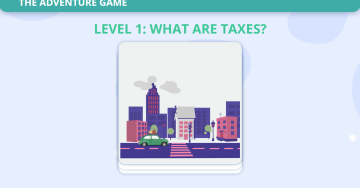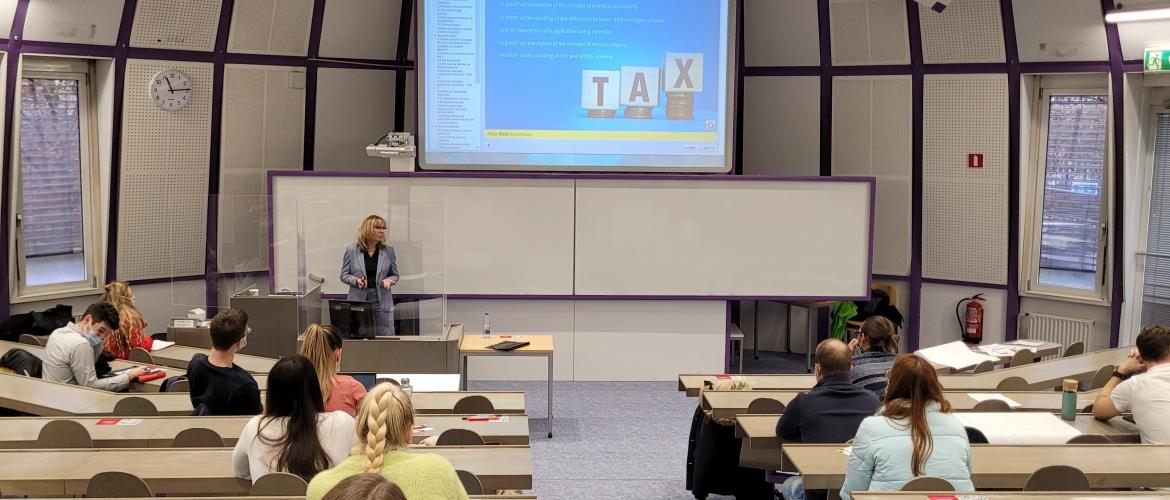Resources

A fun, quizz-based exploration of how and why public authorities collect taxes, with examples of allocation of public funds.

A look into how taxes fund public projects and facilities like schools, hospitals, and roads.

Purpose:
The activity aims at helping students understand the concepts of tax and taxation.
Objectives:
The lesson is an autonomous on-line learning material. It is structured as follows:
• The main characteristics of taxes
• Taxes are a common contribution
• Financing the Common Good
• What sets taxes apart?
• A basic definition for taxes
• Conclusion
The lesson can either be used as a whole, or teachers can use specific sections from the lesson, as they see fit. The average time for attending the entire lesson and the proposed complementary didactic activities is estimated at 30 minutes.
The content of this training course:
- is of general nature only and is not intended to address the specific circumstances of any particular individual or entity;
- does not provide professional or legal advice;
- is valid as of the date of its publication. Updated VAT rates can be consulted on EUROPA.
Only European Union legislation published in the Official Journal of the European Union is deemed authentic.
Materials:
• Micro-clip “What is tax?”
• Interactive whiteboard (or just an LCD projector)
Vocabulary:
tax, taxation

Purpose:
Students should understand the benefits of paying taxes. They should find out examples of early taxes in European history.
Objectives:
• Identify early examples of taxes in European history and funny taxes over time.
• Explain who’s in charge of all the tax money.
• Spot who and how someone benefits from paying taxes.
The content of this training course:
- is of general nature only and is not intended to address the specific circumstances of any particular individual or entity;
- does not provide professional or legal advice;
- is valid as of the date of its publication. Updated VAT rates can be consulted on EUROPA.
Only European Union legislation published in the Official Journal of the European Union is deemed authentic.
Materials:
• Micro-clip “How did taxes come about?”
• Interactive whiteboard (or just an LCD projector)
Vocabulary: taxes, benefits, public services, national services.

Purpose:
Students should understand who has the responsibility of paying taxes nowadays and which are the main categories of taxpayers.
Objectives:
• Identify the necessity of paying taxes and their impact on the community’s well-being.
• Identify the 2 main categories of taxpayers.
• Explain the benefits and responsibilities that someone has from childhood to maturity, when it comes to taxes.
• Debate what kinds of taxes each category should pay for their activities.
The content of this training course:
- is of general nature only and is not intended to address the specific circumstances of any particular individual or entity;
- does not provide professional or legal advice;
- is valid as of the date of its publication. Updated VAT rates can be consulted on EUROPA.
Only European Union legislation published in the Official Journal of the European Union is deemed authentic.
Materials:
• Micro-clip “Who pays taxes nowadays?”
• Interactive whiteboard (or just an LCD projector)
Vocabulary:
Taxes, taxpayers, community, income, social contributions

Purpose:
Students should understand the role of the tax authorities in each Member State and how tax revenue is converted into invaluable investments and public services at the local and national level, ensuring a better quality of life for everybody.
Objectives:
This is an autonomous on-line learning lesson. It is structured as follows:
• Presentation of the general taxation system
• Local taxes and the local budget: examples and general use of local tax funds
• The national budget: the role and types of investments supported by the national budget
• Conclusion
Teachers can use this lesson in its entirety or select specific parts, as they see fit. The estimated time for attending the entire lesson and the proposed complementary activities is 30 minutes.
The content of this training course:
- is of general nature only and is not intended to address the specific circumstances of any particular individual or entity;
- does not provide professional or legal advice;
- is valid as of the date of its publication. Updated VAT rates can be consulted on EUROPA.
Only European Union legislation published in the Official Journal of the European Union is deemed authentic.
Materials:
• Micro-clip “Who collects taxes and why?”
• Interactive whiteboard (or just an LCD projector)
Vocabulary:
taxes, taxation system , local taxes, local budget, national budget, public services, investments





